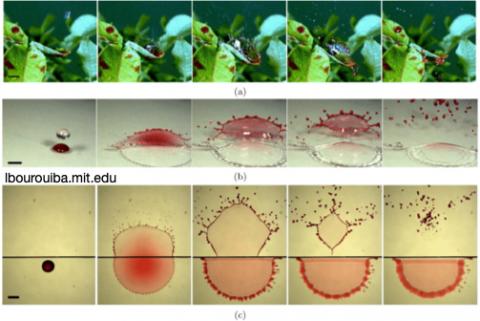Sheet fragmentation from impact of a drop near a surface edge as mimic of impacts on leaves involving drop-on-drop Crescent-moon fragmentation. The edge fragmentation causes one part of the sheet to expand in the air, with fragmentation characterized by an unsteady rim bordering the sheet in the air also governed by the unsteady local Bond = 1 and edge ejections of drops on the sides, contact line retraction, and final collapse of the sheet that can lead to violent ligament breakup.
Image: Liquid sheet formation and fragmentation into droplets, in three configurations. (a) In the field, a raindrop impacts onto a potato leaf on which dyed fluid (red) was deposited. Times are, from left to right, −3, 2, 6, 13, and 29 ms with respect to impact. The sheet is fully three dimensional. (b) A water drop impacts close to a dyed sessile drop on a flat horizontal dry plexiglass substrate. Times are, from left to right, −1, 3, 8, 11, and 23 ms with respect to impact. The sheet is still fully three dimensional. (c) Impact of a dyed drop close to the edge of a flat dry plexiglass substrate. Times are, from left to right, 0, 2.5, 8, 10.5, and 14 ms from impact. The sheet remains largely in the plane of the substrate. Scale bars are 5 mm.
Context: Asymmetric liquid sheet fragmentation is ubiquitous in nature and potentially shapes critical phenomena such as rain-induced propagation of foliar diseases. We investigate the formation and fragmentation of a liquid sheet upon impact of a drop close to the edge of a solid substrate. Both the impact Weber number and the offset, the distance from the impact point to the edge, are systematically varied. Their influence on the kinematics of the liquid sheet and the subsequent statistics of droplet ejection are rationalized. Three major asymmetry scenarios are identified and linked to distinct droplet ejection patterns. Scaling laws are proposed to rationalize these scenarios based on impact parameters. Selection of droplet emission from various mechanisms are highlighted and the implications on propagation of contaminated fluids from impact discussed.

